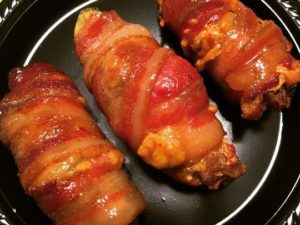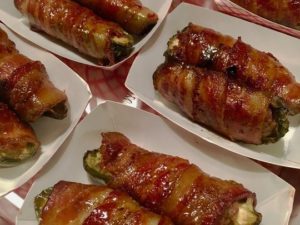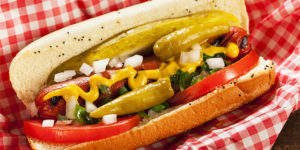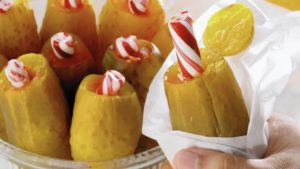HOLY JALAPENOS! Inaugural 901 Popper Throwdown turns up heat
Jennifer Biggs , USA TODAY NETWORK – Tennessee
Seth Agranov loves to fill a jalapeno pepper with just about anything (one of his favorite is a Jack Pirtle’s steak sandwich), wrap it in bacon and throw it on the grill. Then take a picture of it, post it on Facebook and do a little chest thumping about how it turned out.
“I always post my pictures,” Agranov said. “Then a friend started posting his pictures, and it became sort of a ‘my popper is bigger than your popper’ kind of thing.”
So they decided to invite a few folks over and have a culinary cage fight.
“We thought we’d just do it in one of our backyards, and then I realized my wife wouldn’t want people running through the house, coming in to use the restroom or what not, and he said the same thing,” Agranov said.

The sky is the limit when it comes to stuffing jalapeno peppers. (Photo: Photo courtesy Best Memphis Burger)
Luckily, Agranov knows a thing or two about festivals — he’s the co-founder and lead organizer of Best Memphis Burger Festival — and was able to pull one together with his BMBF buddies. They wanted a small venue with beer, so they ended up at High Cotton Brewing Co., where they’re hosting the inaugural 901 Popper Throwdown from 1 to 6 p.m. Saturday.
To keep it all above-board, Agranov isn’t competing, though the Best Memphis Burger tent will be at the festival, giving away samples of burgers, hot dogs and poppers, all for donations that will go to the Best Memphis Burger Festival beneficiary, Memphis Paws.
“There’s no admission fee, so the donations and sales of T-shirts and so on are how we’ll make money,” he said.
Brandie Elliott is a member of Pirates of the Grillibbean, the team that won grand champion of the 2014 BMBF. She and her team have been furiously testing popper recipes and will pick the best two for the judges and cook up a few more to have on hand for folks to try.
“That’s our favorite part of any festival,” she said. “We love feeding people at the tent and raising money.”
No one is giving away their secrets — this is a competition, after all — but Elliott said it’s a good bet that at least one of their poppers will be sweet.
“We have tried everything,” she said. “We’ve stuffed them with everything from ribs to sweet things, and we like the dessert poppers.”
But she admits poppers are not her area of expertise.
“We’re stepping out of the box a little because this is not exactly one of our staples,” she said.
Still, chances are she’s better prepared than her competitor Chris Taylor of MemPops.
“Eh, I have four or five working ideas right now,” he said. “We’ll play around with them on Friday and pick the two we like the best. I can tell you that whatever we end up with, we’re going with fried.
“I entered because I love a good cooking contest, like having a few beers and hanging out with my friends and being outside on what is going to be a beautiful day.”
The name of his team? MemPoppers, of course. The MemPops Airstream will be there to help block off the designated area and to sell its cold treats.
“We’ll even come up with a specialty MemPop, probably a jalepeno-pineapple,” he said.
But just because he doesn’t have a specific recipe ready doesn’t mean that Taylor isn’t ready. He was part of a team that won twice at the Southern Hot Wing Festival.
Agranov wants to keep the competitors to a reasonable number and just hit 15 with the recent addition of Jimmy Sinh, better known as Sushi Jimmi. He’s not taking any more teams, but if you’re just itching to compete, you can always enter the japaleno pepper eating contest. There are 12 gallons of pickled jalapenos, courtesy of La Michoacana, waiting on folks with asbestos tongues and an iron gut.
It’s $10 to enter (or $12.50 if you want to go to reserve your spot online). The prize is $100 — and a year of bragging rights.
Grilled Bacon-wrapped Poppers
Ingredients
6 fresh jalapeno peppers, halved lengthwise and seeded
1 (8 ounce) package cream cheese
12 slices bacon
Directions
Preheat an outdoor grill for high heat. Spread cream cheese to fill jalapeno halves. Wrap with bacon. Secure with a toothpick. Place on the grill, and cook until bacon is crispy.
Source: allrecipes.com
Roasted Jalapeno Poppers
Ingredients
12 large jalapeno peppers
2 ounces feta cheese
4 ounces cream cheese, at room temperature
4 ounces shredded smoked pepper Jack cheese, or other hot pepper cheese, or extra-sharp Cheddar
A small handful fresh cilantro, finely chopped
2 tablespoons grated onion
Directions
Preheat the oven to 425 degrees. Cut 1/3 of each pepper off lengthwise and scoop out the seeds. Place on a baking sheet. If peppers do not sit flat on the baking sheet, slice a thin piece off the bottom of the pepper so it will not roll around.
Mash the feta, cream cheese, shredded cheese, cilantro, and onion together and stuff the peppers with the mixture. Roast for 15 to 18 minutes, or until the peppers are tender and the cheese is brown at the edges and bubbly.
Source: foodnetwork.com
Jalepeno Poppers
Ingredients
12 fresh jalapeños
3 ounces coarsely grated Cheddar (1 cup)
3 ounces coarsely grated Monterey Jack (1 cup)
1 teaspoon hot sauce
3 large eggs
1 cup plain fine dry bread crumbs
2 teaspoons dried oregano
About 4 cups vegetable oil, for frying
Directions
Cut a lengthwise slit from stem to bottom of each pepper. Make a crosswise incision at stem end, forming a T. Pry open enough to hold back long cuts (to expose ribs and seeds), then devein and seed using tip of a paring knife and kitchen shears.
Stir together cheeses, hot sauce, 1/4 teaspoon pepper, and 3/4 teaspoon salt. Fill chiles with cheese mixture, pressing seams closed after filling, so that cheese is compacted and pepper retains its shape.
Lightly beat eggs in a small shallow bowl. Stir together bread crumbs, oregano, and 1/4 teaspoon each of salt and pepper in another shallow bowl.
Dip peppers in egg, letting excess drip off, then coat with bread crumbs, transferring to a work surface. Repeat coating with egg and crumbs to form a second layer.
Heat 2 inches oil to 325 degrees in a medium saucepan. Fry peppers in 3 batches, stirring occasionally, until golden brown all over, 5 to 6 minutes per batch. Transfer to several layers of paper towels to drain. Return oil to temperature between batches.
Source: epicurious.com
901 Popper Throwdown
1-6 p.m. Saturday, March 25, at High Cotton Brewing Co. 598 Monroe. Free admission. 901popperthrowdown.com



